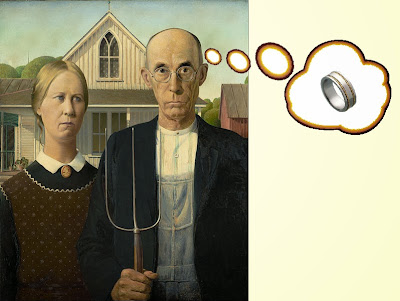November 11, 2013
The Stern Romantic
People who knew my grandfather John might be surprised to hear him described as a romantic guy. A man of few words, he worked hard and went to bed early. He liked old-fashioned westerns and adventure stories; romantic movies put him to sleep quickly.
But he believed in love, devoted, lifelong love. For him, it was love at first sight. The first time he spotted Lida (my future grandmother) in the schoolyard, he said, "That's my girl!" And she was. They were married 54 years, until his death at age 76.
John and Lida were young, fresh and slim on their wedding day. Over time, her own hearty cooking got the better of Lida, and she gradually gained weight. One of the effects of a few extra pounds was that her wedding ring began to get tighter -- and tighter -- and tighter. If she didn't want to lose a finger, the ring had to come off.
Lida was now in a tough situation. Deeply devoted and tradition-minded, she couldn't imagine not wearing a wedding ring. So she bought a cheap ring at the drugstore. When her finger started turning green, she replaced that ring with another, which she wore until it, too, began to deteriorate. This went on for years.
At one point my mother asked John if he couldn't just buy a new wedding ring for his wife, perhaps as a special anniversary gift. He shook his head. "There is only one true wedding ring," he said.
Naturally, people value their wedding rings. The ring symbolizes many things: eternal love, the sharing of our worldly goods with each other, trust and fidelity. But a ring by itself in a box is just a piece of metal. More than the ring alone, it is the act of wearing the ring that has real symbolic value, as the wearer always carries a reminder of those wedding vows and makes it visible to the world. Even so, simply wearing a ring is just a gesture; it is the wearer's behavior, with or without a ring, that tells the real story.
John had confused the symbol with what it symbolized, and as a result was stuck in his strict insistence that it had to be that ring. It was as if the ring itself had been imbued with the all the qualities of love, romance and devotion that it stood for. In fact, those qualities were not in the ring, they were in Lida, as she wore her substitute rings, as she raised the children and kept the house, as she loved and cared for her husband every day. And they were in John, too, as he worked hard, as he remained devoted to his family, as he loved and cared for his wife every day.
The matter of ring was, in the long run, a minor irritation. The problem was eventually solved as Lida aged and grew thinner. She put the ring back on. And they lived happily ever after, as they always had.
Labels:
symbolism
,
vows
,
wedding ring
Subscribe to:
Post Comments
(
Atom
)

Nicely done, Rosemary. After a bit, all symbols lose their meaning. The rings were something' looking back, we could have done without along with much other fanfare before, during and after the wedding. Were we to do it again, it would be far simpler and more about us. Have a weevily one!
ReplyDeleteI will admit that I am very attached to my ring. It means a lot because my husband gave it to me when we made our wedding vows. But if I lost it I would be happy to have him give me a new one.
ReplyDelete